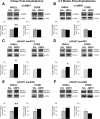Transient overexpression of alpha-Ca2+/calmodulin-dependent protein kinase II in the nucleus accumbens shell enhances behavioral responding to amphetamine
- PMID: 20089902
- PMCID: PMC2825054
- DOI: 10.1523/JNEUROSCI.4383-09.2010
Transient overexpression of alpha-Ca2+/calmodulin-dependent protein kinase II in the nucleus accumbens shell enhances behavioral responding to amphetamine
Abstract
Ca(2+)/calmodulin-dependent protein kinase II (CaMKII) is known to contribute to the expression of psychostimulant sensitization by regulating dopamine (DA) overflow from DA neuron terminals in the nucleus accumbens (NAcc). The present experiments explored the contribution of CaMKII in NAcc neurons postsynaptic to these terminals where it is known to participate in a number of signaling pathways that regulate responding to psychostimulant drugs. Exposure to amphetamine transiently increased alphaCaMKII levels in the shell but not the core of the NAcc. Thus, HSV (herpes simplex viral) vectors were used to transiently overexpress alphaCaMKII in NAcc neurons in drug-naive rats, and behavioral responding to amphetamine was assessed. Transiently overexpressing alphaCaMKII in the NAcc shell led to long-lasting enhancement of amphetamine-induced locomotion and self-administration manifested when alphaCaMKII levels were elevated and persisting long after they had returned to baseline. Enhanced locomotion was not observed after infection in the NAcc core or sites adjacent to the NAcc. Transient elevation of NAcc shell alphaCaMKII levels also enhanced locomotor responding to NAcc AMPA and increased phosphorylation levels of GluR1 (Ser831), a CaMKII site, both soon and long after infection. Similar increases in pGluR1 (Ser831) were observed both soon and long after exposure to amphetamine. These results indicate that the transient increase in alphaCaMKII observed in neurons of the NAcc shell after viral-mediated gene transfer and likely exposure to amphetamine leads to neuroadaptations in AMPA receptor signaling in this site that may contribute to the long-lasting maintenance of behavioral and incentive sensitization by psychostimulant drugs like amphetamine.
Figures






Similar articles
-
Transient viral-mediated overexpression of alpha-calcium/calmodulin-dependent protein kinase II in the nucleus accumbens shell leads to long-lasting functional upregulation of alpha-amino-3-hydroxyl-5-methyl-4-isoxazole-propionate receptors: dopamine type-1 receptor and protein kinase A dependence.Eur J Neurosci. 2010 Apr;31(7):1243-51. doi: 10.1111/j.1460-9568.2010.07155.x. Epub 2010 Mar 19. Eur J Neurosci. 2010. PMID: 20345911 Free PMC article.
-
Persistent reversal of enhanced amphetamine intake by transient CaMKII inhibition.J Neurosci. 2013 Jan 23;33(4):1411-6. doi: 10.1523/JNEUROSCI.4386-13.2013. J Neurosci. 2013. PMID: 23345217 Free PMC article.
-
Inhibition of CaMKII in the nucleus accumbens shell decreases enhanced amphetamine intake in sensitized rats.Neurosci Lett. 2008 Oct 24;444(2):157-60. doi: 10.1016/j.neulet.2008.08.004. Epub 2008 Aug 7. Neurosci Lett. 2008. PMID: 18694805 Free PMC article.
-
Maladaptive consequences of repeated intermittent exposure to uncertainty.Prog Neuropsychopharmacol Biol Psychiatry. 2020 Apr 20;99:109864. doi: 10.1016/j.pnpbp.2020.109864. Epub 2020 Jan 15. Prog Neuropsychopharmacol Biol Psychiatry. 2020. PMID: 31952958 Free PMC article. Review.
-
Sensitization of midbrain dopamine neuron reactivity and the self-administration of psychomotor stimulant drugs.Neurosci Biobehav Rev. 2004 Jan;27(8):827-39. doi: 10.1016/j.neubiorev.2003.11.001. Neurosci Biobehav Rev. 2004. PMID: 15019432 Review.
Cited by
-
A Critical Role for the GluA1 Accessory Protein, SAP97, in Cocaine Seeking.Neuropsychopharmacology. 2016 Feb;41(3):736-50. doi: 10.1038/npp.2015.199. Epub 2015 Jul 7. Neuropsychopharmacology. 2016. PMID: 26149358 Free PMC article.
-
Stimuli associated with the presence or absence of amphetamine regulate cytoskeletal signaling and behavior.Eur Neuropsychopharmacol. 2016 Nov;26(11):1836-1842. doi: 10.1016/j.euroneuro.2016.09.639. Epub 2016 Oct 6. Eur Neuropsychopharmacol. 2016. PMID: 27720500 Free PMC article.
-
Repeated Yueju, But Not Fluoxetine, Induced Sustained Antidepressant Activity in a Mouse Model of Chronic Learned Helplessness: Involvement of CaMKII Signaling in the Hippocampus.Evid Based Complement Alternat Med. 2022 Feb 24;2022:1442578. doi: 10.1155/2022/1442578. eCollection 2022. Evid Based Complement Alternat Med. 2022. PMID: 35251201 Free PMC article.
-
Transient viral-mediated overexpression of alpha-calcium/calmodulin-dependent protein kinase II in the nucleus accumbens shell leads to long-lasting functional upregulation of alpha-amino-3-hydroxyl-5-methyl-4-isoxazole-propionate receptors: dopamine type-1 receptor and protein kinase A dependence.Eur J Neurosci. 2010 Apr;31(7):1243-51. doi: 10.1111/j.1460-9568.2010.07155.x. Epub 2010 Mar 19. Eur J Neurosci. 2010. PMID: 20345911 Free PMC article.
-
Rewarding Social Interaction in Rats Increases CaMKII in the Nucleus Accumbens.Biomedicines. 2021 Dec 12;9(12):1886. doi: 10.3390/biomedicines9121886. Biomedicines. 2021. PMID: 34944702 Free PMC article.
References
-
- Anderson SM, Famous KR, Sadri-Vakili G, Kumaresan V, Schmidt HD, Bass CE, Terwilliger EF, Cha JH, Pierce RC. CaMKII: a biochemical bridge linking accumbens dopamine and glutamate systems in cocaine seeking. Nat Neurosci. 2008;11:344–353. - PubMed
-
- Bell K, Duffy P, Kalivas PW. Context-specific enhancement of glutamate transmission by cocaine. Neuropsychopharmacology. 2000;23:335–344. - PubMed
-
- Benavides DR, Bibb JA. Role of cdk5 in drug abuse and plasticity. Ann N Y Acad Sci. 2004;1025:335–344. - PubMed
-
- Bennett MK, Erondu NE, Kennedy MB. Purification and characterization of a calcium/calmodulin-dependent protein kinase that is highly concentrated in brain. J Biol Chem. 1983;258:12735–12744. - PubMed
-
- Bibb JA, Chen J, Taylor JR, Svenningsson P, Nishi A, Snyder GL, Yan Z, Sagawa ZK, Ouimet CC, Nairn AC, Nestler EJ, Greengard P. Effects of chronic exposure to cocaine are regulated by the neuronal protein cdk5. Nature. 2001;410:376–380. - PubMed
Publication types
MeSH terms
Substances
Grants and funding
LinkOut - more resources
Full Text Sources
Molecular Biology Databases
Miscellaneous
